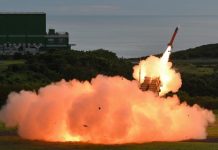Two years ago the UK’s Ministry of Defense (MOD) had mooted the idea of retiring the BAE 146 aircraft that was being used exclusively for VIP transport. Last year, the MOD officially confirmed that it was going to replace its four Royal Air Force BAE 146 planes with two civil business jets.
The Dassault Falcon has been chosen to replace the recently retired BAE 146 aircraft operated by the RAF, reported Janes.
On February 8, MOD announced a GBP80 million (USD109 million) order for two Falcon 900LX aircraft with a Bristol-based supplier Centreline providing the tri-jets. The new aircraft will be allocated to RAF’s 32 Squadron (The Royal).
“The contract with Centreline, placed by Defense Equipment and Support (DE&S) – the MoD’s procurement arm – includes the purchase of two Dassault 900LX aircraft and two years of initial support, plus three option years if required,” the ministry said, adding, “[The] Dassault 900LX was successful in this competition as the standout candidate in performance, cost value, and time requirements”.
The development comes shortly after the MoD announced last month that two BAE146 Mk2 aircraft were to join the British Airliner Collection in Duxford, Cambridgeshire, and the South Wales Aviation Museum in St Athan, South Glamorgan as the latest exhibits. It had also informed that the other two aircraft, the BAE146 Mk3 that entered service with the RAF in 2013 are also being retired and sold to a civilian operator.
The Falcon 900LX aircraft will be operated by a mixed crew of civilian and RAF personnel at first, according to the MoD. It will be modified with missile jamming devices and military communications once RAF takes over its operation completely.
Dassault Falcon trijets to replace RAF’s VIP-roled BAe 146s https://t.co/0XkT3CRAwB pic.twitter.com/KIuYIDBZva
— FlightGlobal (@FlightGlobal) February 8, 2022
The Royal or 32 Squadron, based at RAF Northolt in north London, historically flew two BAE 146 C2s in the fixed-wing VVIP role (with another two converted for tactical transport missions) until March 2021, when the aircraft was discontinued.
The Falcon 900LX is being purchased as part of the Command Support Air Transport Recapitalization (CSAT RECAP) project, which intends to replace the BAE 146 capabilities through a two-phase procurement approach.
The tender of the project had categorically mentioned that these aircraft will be owned by the Ministry of Defense, but they will be treated as civilian planes and piloted by civilians provided by contractors.

Phase one would entail the training of military pilots and cabin crew, as well as the utilization of these service members to assist civilian pilots in delivering the service.
In the second phase, a separate competitive procurement will be initiated to implement military modifications on the aircraft beginning April 1, 2024, and provision of in-service support involving military personnel in the operation of the aircraft.
Dassault Falcon 900LX Aircraft
The Falcon 900LX is the successor to the Falcon 900EX, which debuted in 1996. French aircraft aerospace giant Dassault Aviation is responsible for its production.
The Falcon 900LX keeps the majority of the 900EX’s design elements. The landing gear on the Falcon 900LX is a retractable tricycle. The landing gear is electronically operated and hydraulically activated, with two wheels on each unit. Two more fuel tanks are installed on the aircraft. A 28V DC electrical system with two batteries, three starter generators, and three separate bus bars is also included.
Aviation Partners designed new high-mach blended winglets for the aircraft. FACC manufactured the winglets, which were delivered to Dassault in October 2011. The winglets contribute to a 40% reduction in fuel consumption.
The aircraft’s length, height, and wingspan are 20.21m, 7.55m, and 21.38m, respectively.
A synthetic vision system (SVS), Runway Awareness and Advisory System (RAAS), flight management system, and better display symbology are all included in the Falcon 900LX. It also boasts better takeoff and landing capabilities.
The aircraft’s navigation system comprises WAAS and EGNOS LPV. It also includes Europe’s new data-compliant controller, pilot data link communication, or air traffic network, as well as the future air navigation system (FENS 1A). Automated descent mode (ADM), XM graphical weather integrated with the INAV map, and automatic dependent surveillance-broadcast (ADS-B) are all included in the aircraft.
“The 900LX features 35-40% better efficiency than other airplanes in its class. It can fly from New York to Moscow; Paris to Beijing and Mumbai to London. EASA and FAA certifications were achieved in July of 2010”, according to Dassault Aviation.
The large-cabin #Falcon900LX is the latest in the #Dassault Falcon 900 series. This newest model offers an improved range and less fuel consumption than its predecessor, the Falcon 900EX. Learn more about the Falcon 900LX in our Overview here: https://t.co/BwRLUwsRfW pic.twitter.com/CVOZxFrObV
— Jetcraft (@JetcraftCorp) July 26, 2021
Three Honeywell TFE731-60 turbofan engines, each producing 22.24kN of thrust, power the aircraft. In normal mode, the engine is controlled by a Digital Electronic Engine Control (DEEC), which was designed and built by Garrett AiResearch. In backup mode, the engine is additionally outfitted with a hydro-mechanical control.
The aircraft has a maximum range of 4,750nm and a maximum cruise speed of 950km/h. The aircraft’s maximum takeoff weight is 22,225kg, while its maximum landing weight is 20,185kg.
- Contact the author at sakshi.tiwari9555@gmail.com
- Follow EurAsian Times on Google News




